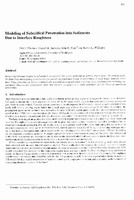| dc.contributor.author | Thorsos, Eric I. | |
| dc.contributor.author | Jackson, Darrell R. | |
| dc.contributor.author | Moe, John E. | |
| dc.contributor.author | Wiliams, Kevin L. | |
| dc.date.accessioned | 2018-10-11T14:08:31Z | |
| dc.date.available | 2018-10-11T14:08:31Z | |
| dc.date.issued | 1997 | |
| dc.identifier | 11518 | |
| dc.identifier.govdoc | CP-45 | |
| dc.identifier.uri | http://hdl.handle.net/20.500.12489/473 | |
| dc.description.abstract | Recent experimental results reveal acoustic penetration into sandy sediments at grazing angles below the critical angle. We have been investigating a mechanism for subcritical penetration based on scattering at a rough water-sediment interface. Using perturbation theory, a numerically tractable three-dimensional model has been developed for simulating experiments. Data-model comparisons show that interface roughness is a viable 11)pothesis for the observed subcritical penetration. | |
| dc.format | 7 p. : ill. ; digital, PDF file | |
| dc.language | English | |
| dc.publisher | NATO. SACLANTCEN | |
| dc.source | In: High Frequency Seafloor Acoustics (SACLANTCEN Conference Proceedings CP-45), 1997, pp. 563-570 | |
| dc.subject | Seafloor sediments | |
| dc.subject | Buried objects detection | |
| dc.subject | Mine burial and bottom conditions | |
| dc.subject | High Frequency Acoustics | |
| dc.subject | Acoustic scattering - Seafloor and sea surface | |
| dc.subject | Perturbation (Mathematics) | |
| dc.subject | Modelling and simulation | |
| dc.title | Modeling of subcritical penetration into sediments due to interface roughness | |
| dc.type | Papers and Articles | |
| dc.type | Conference Proceedings (CP) | |
